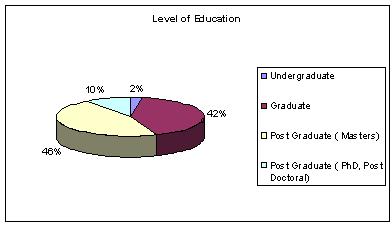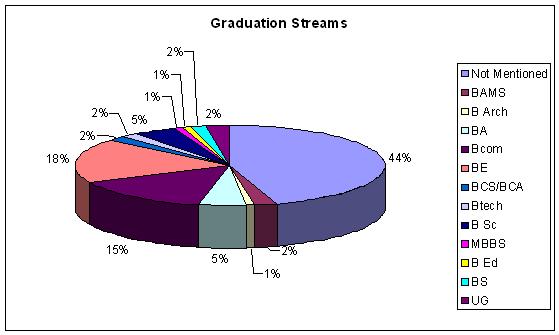Primary Information
A primary information of the survey takers helps in understanding a general background of the cross section of the society being surveyed. It can be crucial for the further analysis of the responses in the questionnaire.
We asked eleven questions in this section which were mandatory in nature. We could sketch an image of the respondent based on the information she provided.
- Age group:
66% women fall under the age group 21 to 40 years.
14% women fall under the age group 41 to 50 years.
Only 1% women have crossed 61 years of the age.
- Education:

10% women have a doctorate degree (PhD). The percentage of women having a graduate and a post graduate degree is almost the same.
2% (three) women have an under graduate degree.
- Degree and field of education

BAMS: Bachelor of Ayurvedic Medicine & Surgery, BArch: Bachelor of Architecture, BA: Bachelor of Arts, BCom: Bachelor of Commerce, BE: Bachelor of Engineering, BCS: Bachelor of Computer Science, BCA: Bachelor of Computer Application, BTech: Bachelor of Technology, BSc: Bachelor of Science, MBBS: Bachelor of Medicine and Bachelor of Surgery, BEd: Bachelor of Education, BS: Bachelor of Science, UG: Undergraduate
- Current employment status
- Current place of residence
At present, 39% women live in India in cities like Pune, Mumbai, Nashik, Ahmednagar, Sindhudurga, Vapi, Hyderabad, and Ratnagiri. (Out of these, most women live in either Mumbai or Pune). 61% women live outside of India – in USA, UK, UAE, Germany, Dubai, Australia, and Korea.
90% women lived in India during 0 to 20 years of age, in the following cities: Pune, Mumbai, Kolhapur, Satara, Sangali, Vaai, Aurangabad, Dhule, Nagpur, Nevasa, Nashik, Karad, Ratnagiri, Shrirampur, Chennai, Roorkee and Vishakhapattanam.
It would be interesting to note that none of the respondents are currently living in the following cities: Vishakhapattanam, Kolkata, Chennai, Roorkee, Shrirampur, Satara, Sangali, Vaai, Aurangabad, Nevasa, Dhule and Karad. From this, we can certainly conclude that none of our respondents were from rural areas of India.
We intended to study the extent to which opinions of non-Indian women differ from the opinions of Indian women, but we did not have enough data from women of non-Indian origin. Therefore, a direct relationship between the two could not be inferred and established. Yet, some responses do indicate these differences.
- Economic status
All the women have mentioned their economic status as middle class (51%) and upper middle class (49%). Interestingly, none of them chose any of the other options. This is an important aspect of the responses received in general.
According to the responses, there is not much of a difference between the economic status of women in India and those living outside of India Regarding the economic status, we did not specifically ask the participants their salary/household income. So based on what they informed about their economic status, we can only say that all of them belong to a middle or an upper middle class.
- Children
61% women have one or more children. 39% women have at least 1 child, 20% have 2 children and 2% have 3 children. One of the women who has 3 children is of non-Indian origin.
As such, age of the children was not a part of the survey. Neither did we ask the age of the woman when she had her first child. But it would be worth the mention that at present, 2 women between 20 to 25 years of age are pregnant and both originally belong to India but are currently living outside of India.
- Family status
At present, 77% women do not live in a joint family [1]. They might have lived in a joint family in the past, but that was not a part of our survey. So we cannot make any generalizations in that respect. 12% women live with their parents or in-laws. Out of these, no married woman lives with her parents at present. Only one woman lives with her mother (Her relationship status cannot be disclosed for the reason of confidentiality). Only one woman who is of non-Indian origin lives in a joint family. 7% women live in a joint family comprising of family members like grand father-in-law, grand mother-in-law, brother, brother-in-law, sister-in-law, nephew, mother-in-law, father-in-law etc. Only one who is of Indian origin (non-Marathi speaking), lives abroad in a joint family.
The families of the participants consist of minimum 1 and maximum 9 family members including the woman herself.
--------------------------------------------------------------------------------
[1] A joint family consists of anybody else other than you, your partner and your kids. It could be parents, in-laws, or anybody related to you. - Race/Religion/Country/Caste/Native language
Total 122 women participated in the survey. Out of these, 112 women are of Indian origin and 10 are of non-Indian origin. Most of them are American and/or White Caucasian (One of them is of half white and half Indian origin.)
Among Indian women, 6 women did not mention their religion or caste for several reasons – because they found it unnecessary or pointless, because they did not believe in those concepts and had firm opinions about it. From the remaining 106 women, 4 are Jain and the rest follow Hinduism (most of them are Brahmins by caste). Since most of the women belonged to a particular religion and caste, we could not verify whether religion or caste influences the thinking process of women. Therefore, we could not consider religion or caste as an influencing factor while analyzing.
Do you find this scenario encouraging? Do you think that this could also be linked to the respondents’ economic status? We would like to hear your thoughts/opinions in this regard.
Native language of the participants:
The native language of most of the participants was mainly Marathi. Other responses included Polish, Lithuanian, English, Tamil, Telugu, Kannada, Bengali, and Oriya as their native language.
- Relationship status:
The relationship status of the women who participated in the survey is as follows:
- Sexual orientation:
All women responded that they are heterosexual.
Most of the women who responded to the questionnaire are:
- Mainly Marathi speaking
- Currently not living in a joint family
- In the age group of 21 to 40 years
- Of Indian origin, mainly Hindu and Brahmin by caste
- Presently living outside of India
- Presently living in the Indian cities of Mumbai and Pune
- Have graduate or post-graduate degrees
- Have a full time job
- Mostly married
- Have 1 child minimum and 3 children maximum.
As a reader and/or respondent of this survey, we would love to know your views and opinions on this section.

